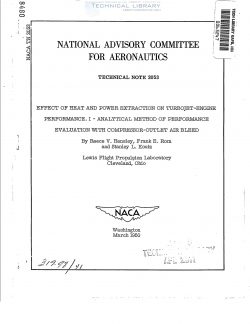naca-tn-2053
- Version
- 103 Downloads
- 2.53 MB File Size
- 1 File Count
- December 9, 2016 Create Date
- December 9, 2016 Last Updated
National Advisory Committee for Aeronautics, Technical Notes - Effect of Heat and Power Extraction on Turbojet Engine Performance - I - Analytical Method of Performance Evaluation with Compressor Outlet Air Bleed

The performance of a turbojet engine with air bled off at the
compressor outlet is analytically_investigated. The analysis is
based on the experimentally determined characteristics of the com-
ponents of a typical axial-flow-type turbojet engine. Changes in
the matching characteristics of the engine components and the
change of the mass of working fluid within the cycle are accounted
for in the analysis. A wide range of engine and flight conditions
is covered and‘air bleeds from O to 15 percent of the air mass flow
through the compressor are considered.
The results are presented in nondimensional form to facili-
tate their application to different engines and are applicable for
turbojet engines with pressure ratios of 4 to 5 and turbine—inlet
temperatures of approximately 20000 R. For engines outside this ‘
range as well as for centrifugal-flow-type engines, the method for
calculating the effect of air bleed as set forth in this analysis is
still applicable. Results of the analysis are presented both as
functions of the pressure and temperature ratios across the engine
and in terms of the conventional propulsion-system characteristics
in corrected form: engine speed, turbine-inlet temperature, tail-
pipe-nozzle area, thrust, and specific fuel consumption.
In the course of the analysis, it was found that the over-all
engine temperature and pressure ratios were extremely sensitive to
the tail-pipe-nozzle area and the prediction of constant-area per- .
formance was consequently difficult. If any given variation of
tail-pipe temperature with air bleed is used, however, such as
holding tail-pipe temperature constant, excellent checks are
obtained between the experimental and analytical performance of
axial-flow-type turbojet engines with air bleed.
In the operation of current and future aircraft, consider-
able quantities of compressed air may be required for such uses,
as cabin pressurization and conditioning, protection against ice
formation, and boundary—layer control. The compressed air can
be obtained from auxiliary equipment; such equipment, however,
requires space and reduces the pay—load capacity of the airplane.
In addition to these disadvantages, the auxiliary equipment must
be designed for peak loads that occur only for small fractions of
the total flight time.
| File | Action |
|---|---|
| naca-tn-2053 Effect of Heat and Power Extraction on Turbojet Engine Performance - I - Analytical Method of Performance Evaluatio.pdf | Download |

Comment On This Post